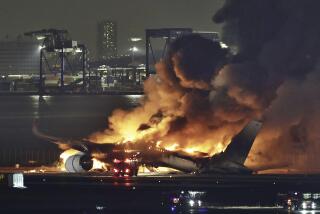Asiana crash not expected to damage airline long-term
- Share via
Before Asiana Airlines Flight 214 struck a sea wall at the edge of San Francisco International Airport, the Seoul-based carrier was planning a huge expansion of its fleet in hopes of capitalizing on the surge in air traffic from Asia.
The devastating crash Saturday that killed two teenagers and sent 182 passengers to hospitals now throws into question the future of South Korea’s second-largest airline — a carrier that was recently ranked one of the world’s best.
The key to overcoming damage to the company’s once highly rated reputation, according to experts, is for Asiana’s executives to quickly make any safety improvements needed to prevent another tragedy in the future.
“The airline needs to show customers that it is still in charge of a very safe and reliable operation,” said Henry Harteveldt, a travel industry analyst with New York-based Hudson Crossing.
Although the crash landing might make travelers skittish about flying Asiana in the short term, Harteveldt and other aviation experts say previous airline accidents have shown that ticket sales will rebound.
“If the airline does its work in the right way, I don’t anticipate that there will be any long-term damage,” he said.
Federal investigators looking into the accident are focusing on whether the plane’s automatic throttle had failed to keep the Boeing 777 at the proper speed for landing. It was the first time pilot Lee Hang-kook had tried to fly a 777 into San Francisco International Airport.
Shortly before the impact with the runway sea wall, investigators said, the plane was flying under its target landing speed and had dipped below the normal flight path into the airport. Seconds before the crash landing, a stall warning went off in the cockpit.
Asiana, which launched operations in 1988, runs a fleet of 79 planes and had announced plans to add 40 new Airbus A350 extra-wide-body planes and six massive A380 jumbo jets to serve routes to Los Angeles and New York. Asiana is expected to take delivery of the new planes by 2017.
Asiana currently flies two daily nonstop departures from Los Angeles International Airport to Incheon.
Asiana stock dropped about 6% on the Monday after the accident and recovered slightly, gaining 1% on Tuesday.
Asiana officials did not return calls requesting comment about the carrier’s future, but some aviation experts say the airline should halt any expansion plans until the cause of the accident is determined and the carrier adopts an aggressive safety improvement strategy.
“They have to prove now that they have solved this problem,” said Julius Maldutis, president of the New York-based aviation consultant group Aviation Dynamics. “Once they solve that they can resume their growth plan.”
Asiana has earned a reputation for outstanding service, winning the Airline of the Year award by the industry magazine Air Transport World in 2009 and the Best Airline award by the Britain-based rating firm Skytrax in 2010. Asiana came in third in 2011 and second in 2012 in Skytrax’s rating.
The goal of the proposed expansion, aviation experts say, is for Asiana to better challenge its bigger rival, Korean Air, which operates a fleet of 121 passenger planes and 28 cargo planes.
Korean Air flies two daily departures from Los Angeles to Seoul, one of which uses the A380, which can seat more than 400 passengers. It also flies three additional weekly flights from Los Angeles International Airport with a Boeing 777.
Additional flights can be added by both carriers because LAX is working to complete an expansion and modernization plan that will include 18 gates, nearly half of which will be able to serve the massive A380 planes.
Korean Air and Asiana Airlines are positioned to reap the benefits of a surge in trade, business and leisure travel among Asia, the U.S. and Europe, said Michael Boyd, chairman of Boyd Group International, an aviation consulting firm in Colorado.
“Between Asiana and Korean Air, Incheon is going to be the next Dubai,” he said, referring to the international airport that has become the gateway to the Middle East.
The airlines are also capitalizing on the surge in Korean tourists that began after 2008 when the U.S. added South Korea to its visa waiver program, allowing Korean visitors to stay up to 90 days without a visa.
The number of visitors from South Korea to California has jumped from 277,000 in 2009 to 410,000 in 2011, according to state tourism statistics. Korean visitors bring plenty of revenue to the state, spending an average of $2,173 per visit, compared with $1,883 for all overseas visitors to California, according to state statistics.
The accident in San Francisco is not the first for Asiana. In July 2011, an Asiana Airlines cargo plane crashed off the southern coast of South Korea, killing two crew members. The cause of the accident was determined to be a fire in the cargo hold area.
Although the crash put the spotlight on aviation safety, the world’s airline industry just came off the safest year for air travel since 1945.
Airlines, including passenger and cargo flights, reported only 23 accidents last year resulting in 475 fatalities, compared with the 10-year average of 34 accidents and 773 fatalities per year, according to the Netherlands-based Aviation Safety Network, a private online operation.
More to Read
Inside the business of entertainment
The Wide Shot brings you news, analysis and insights on everything from streaming wars to production — and what it all means for the future.
You may occasionally receive promotional content from the Los Angeles Times.










